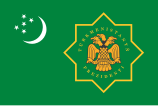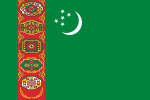Flag of Turkmenistan
 | |
| Türkmenistanyň baýdagy (Turkmen) | |
| Use | National flag |
|---|---|
| Proportion | 2:3 |
| Adopted | 19 February 1992 (original version) 24 January 2001 (current version) |
| Design | A green field with a vertical red stripe near the hoist side, containing five carpet guls stacked above two crossed olive branches; a white waxing crescent moon and five white five-pointed stars appear in the upper field, to the fly side of the red stripe |
 | |
| Use | Presidential standard |
| Proportion | 2:3 |
| Adopted | 27 September 1992 (original version) 14 February 2007 (current version) |

The national flag of Turkmenistan (Turkmen: Türkmenistanyň baýdagy) features a white crescent and five stars representing the five regions of the country and the Five Pillars of Islam. Placed upon a green field is a symbolic representation of the country's famous carpet industry. It was introduced as the flag of Turkmenistan on 27 September 1992 to replace the Soviet-era flag which consisted of a red background with two light blue bars in the middle. The modified version with a 2:3 ratio was adopted on 23 January 2001. State Flag and Constitution Day is celebrated on 18 May.[1]
Design
[edit]Description
[edit]It features a green field with a vertical red stripe near the hoist side, containing five carpet guls (designs used in producing rugs) stacked above two crossed olive branches similar to those on the flag of the United Nations; a white waxing crescent moon, typical of Turkic and Islamic symbology, and five white five-pointed stars appear in the upper corner of the field just to the fly side of the red stripe.
Colors
[edit]| Color scheme[2] | Green | Red | Yellow | Black | ||||
|---|---|---|---|---|---|---|---|---|
| Pantone | 348 C | 1795 C | 123 C | Black C | ||||
| RGB | 0–133–58 | 210–38–48 | 255–199–44 | 56–55–57 | ||||
| CMYK | 100-0-56-48 | 0-82-77-18 | 0-22-83-0 | 2-4-0-78 | ||||
| Web colors | 00853A | D22630 | FFC72C | 383739 | ||||
Symbolism
[edit]While no official explanation has been given for the symbolism of the flag's colors or white symbols, there are several leading theories. Some such as the Russian Centre of Vexillology and Heraldry claim that the green field stands for life, land, grass, prosperity, and peace, while the crescent moon symbolizes the clear sky above Turkmenistan's people. They claim the stars represent the five provinces (welaýatlar) of Turkmenistan: Ahal, Balkan, Daşoguz, Lebap and Mary.[3] Soon after the flag was adopted, multiple newspapers gave their own explanations of the flag's symbolism, claiming that the color green was chosen to resemble banners historically used by the Turkmen people, and the color white was chosen to represent the brightness of life. They also reported that the five points on the stars represented the five states of matter, solid, liquid, gas, plasma, and crystal, while the number of stars represented the five main preconditions of life, light, sound, taste, smell, and feeling. The newspapers stated that stars and crescent moon together symbolized the belief in a bright future.[4]
The five traditional carpet guls represent the five major tribes of Turkmenistan, and form motifs in the country's state emblem and flag. The Turkmen tribes in traditional order (as well as top to bottom) are the Teke, Yomut, Saryk, Chowdur, and Ersari.[1] The middle design may also represent the Salur, a tribe that declined as a result of military defeat before the modern period.
-
Teke
-
Yomut
-
Saryk
-
Chowdur
-
Ersari
History
[edit]Turkmen Soviet Socialist Republic
[edit]On October 6, 1926, the Constitution of the Turkmen SSR was adopted, instating the first flag of the Turkmen Soviet Socialist Republic. The flag was a red field, with a gold-bordered red star and golden hammer and sickle in its canton.[5] On March 2, 1937, a new constitution was adopted, changing the flag to a red banner with the gold letters "T.S.S.R." in its canton.[6] On July 19, 1940, the Latin letters in the canton were changed to Cyrillic letters, to match the Republic's new alphabet. The letters in the canton were now "T.C.C.P.".[7] On August 1, 1953, a decree from the Presidium of the Supreme Soviet of the Turkmen SSR changed the flag to a red field with two horizontal blue bars in its middle, and a golden hammer and sickle and gold-bordered red star in its canton. The state constitution was amended to address this change.[8] On September 23, 1974, the Presidium again modified the flag, moving the star and hammer and sickle to border the hoist.[9] No modifications would be made to the flag's design until Turkmenistan gained independence.

Modern flag
[edit]After independence in 1991, the government of Turkmenistan decided to change its national symbols, including the flag. In early February 1992 an exhibition was held at the hall of the Union of Artists in Ashgabat, which displayed proposed flags and coats of arms from across the country. That same month, members of the 13th meeting of the Supreme Soviet were tasked with choosing a flag from the proposed designs. On February 19, 1992, the new flag was signed into law. On March 21, 1992, the Turkmen New Year, president Saparmurat Niyazov raised the flag for the first time.[4] On 1 February 1997, an olive branch was added to symbolise the peace-loving nature of the Turkmen people. The positioning of the crescent and stars was also changed, with the crescent positioned roughly to its current position but with the stars in a much more uneven position. In 2001, the flag's proportion was changed from 1:2 to 2:3 and the green field was made lighter.[10]
| Flag | Date | Use | Description |
|---|---|---|---|

|
1926–1937 | Flag of the Turkmen SSR | A plain red field with a golden hammer and sickle and a gold-bordered red star in its canton |

|
1937–1940 | A plain red field with the golden letters TSSR in its canton | |

|
1940–1953 | A plain red field with the golden letters ТССР in its canton | |

|
1953–1973 | A red field with two blue bars transversing it in the middle. A golden hammer and sickle and a gold-bordered red star are placed in its canton | |

|
1974–1992 | Similar to the previous flag, with the golden hammer and sickle, and gold-bordered start placed to border the hoist | |

|
1992–1997 | Flag of Turkmenistan | A green field with a 1:2 proportion. A vertical red stripe is near the hoist side, containing five carpet guls. A white crescent moon and five white five-pointed stars are placed to the right of the stripe |

|
1997–2001 | Similar to the previous flag, with a golden olive branch added to the bottom of the red stripe | |

|
2001–present | Similar to the previous flag, with a lighter shade of green and a 2:3 proportion |
See also
[edit]References
[edit]- ^ a b Tenora, Jiri. "The National Flag of Turkmenistan of 1992" (PDF). Raven. 2: 65–78.
- ^ УКАЗ Президента Туркменистана О внесении изменений и дополнений в некоторые Указы Президента Туркменистана [DECREE of the President of Turkmenistan On introducing amendments and additions to some Decrees of the President of Turkmenistan] (Decree) (in Turkmen). President and chairman of the Cabinet of Ministers of Turkmenistan. September 2, 2017. Retrieved June 18, 2024.
- ^ "Государственный флаг Туркменистана" [National flag of Turkmenistan] (in Russian). Russian Centre of Vexillology and Heraldry. 20 January 2018. Retrieved 11 May 2024.
- ^ a b Basov, A.N. (May 1992). "Zpravodaj Vexilologického Klubu v Praze 3" (PDF). Vexilologie (in Czech) (85): 1668–1670. Retrieved 11 May 2024.
- ^ Central Executive Committee of the Turkmen SSR (1928), "Конституция (Основной закон) Туркменской Советской Социалистической Республики" [Constitution of the Turkmen Soviet Socialist Republic], naukaprava.ru (in Russian and Turkmen), Ashgabat: Turkmen State Publishing, retrieved May 21, 2024
- ^ Supreme Soviet of the Turkmen SSR (1937), Конституция (Основной закон) Туркменской Советской Социалистической Республики [Constitution of the Turkmen Soviet Socialist Republic], naukaprava.ru (in Russian), Ashgabat: Turkmenpartizdat, retrieved May 21, 2024
- ^ Supreme Soviet of the Turkmen SSR (1940), Конституция (Основной закон) Туркменской Советской Социалистической Республики [Constitution of the Turkmen Soviet Socialist Republic], naukaprava.ru (in Russian), Ashgabat: Turkmen State Publishing, retrieved May 21, 2024
- ^ Supreme Soviet of the Turkmen SSR (1957), Конституция (Основной закон) Туркменской Советской Социалистической Республики [Constitution of the Turkmen Soviet Socialist Republic], naukaprava.ru (in Russian), Ashgabat: Turkmen State Publishing, retrieved May 21, 2024
- ^ Supreme Soviet of the USSR (1985), Конституция (Основной Закон) Союза Советских Социалистических Республик. Конституции (Основные Законы) Союзных Советских Социалистических Республик [Constitution of the USSR. Constitution of the Soviet Socialist Republics], naukaprava.ru (in Russian), Moscow: News of the Soviets of People's Deputies of the USSR, retrieved May 21, 2024
- ^ "Turkmenistan". Flags of the World. Retrieved 19 May 2024.





